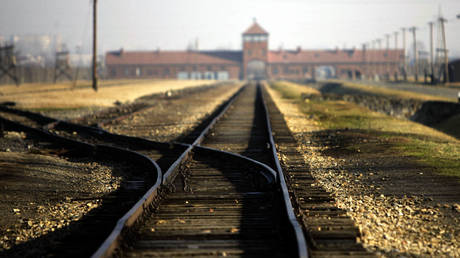
There were days when up 30,000 people were burnt at Auschwitz-Birkenau facility, according to recollections by an escaped inmate
A declassified report by a Soviet prisoner of war who managed to escape the Auschwitz-Birkenau concentration camp, shares shocking detail of how thousands were executed at the infamous Nazi death facility and how tough it was to survive for those who were left alive and forced to work.
The Russian Federal Security Service (FSB) has dedicated the release of the historic document to the 78th anniversary of the liberation of Auschwitz-Birkenau camp by Soviet forces, which is marked on Friday.
Over a million people, mainly Jewish, Polish and Soviet prisoners, were executed at the death camp in southern Poland between 1940 and 1945, with senior lieutenant Pavel Gavrish being a witness to many of those terrifying events.
Thousands of Soviet prisoners of war brought to Auschwitz in late 1941 and early 1942 were used by the Nazis for the construction of Birkenau – the largest of the more than 40 camps and sub-camps that made up the death facility.
In an essay that Gavrish wrote in 1944, shortly after escaping Auschwitz-Birkenau, he said that only 140 people out of 12,000 POWs that the Nazis, “filled with slander for the Russian people,” had sent to the construction site survived.
“Starving, threadbare and sinking into the mud, they died by the hundreds every day,” he recalled. “The Birkenau camp was called the grave of the living. Bones of Russian prisoners of war and a stone laid the foundation of this camp.”
The Soviet officer also described the design of the infamous Auschwitz crematorium, which, in his words, was equipped with “state-of-the-art Nazi technology.”
This “enterprise to exterminate humanity” consisted of a leakproof gas chamber for 3,000 people with a window through which a gas container was deployed, and another premises that contained 15 ovens, the Soviet officer wrote. The two areas were connected by rail tracks, with cars used to deliver dead bodies to the incinerators.
“There were days when the number of those burnt reached 25,000 to 30,000 people,” Gavrish wrote. The victims, including elderly, women and children, were told that they were going to a bathhouse as they were sent to their death.
All of the Jews arriving at Auschwitz-Birkenau were killed, while some of the young and more healthy representatives of other nationalities were spared and turned into workers at the camp.
“An inmate stopped being a human being, becoming a slave with a number on his chest,” the report read. The daily rations consisted of just “three quarters of a liter of soup, 250 grams of ersatz-bread and 20 grams of ersatz-cheese, which wasn’t always available in full.” The most exhausted prisoners were picked by doctors, gathered together in a barns, starved for several days and then sent straight to the crematorium, Gavrish recalled.
Up to a hundred people died during forced labor every day, as supervisors who’d been recruited from the ranks of German and Polish criminals were encouraged to reduce the number of inmates. “Only a small number of prisoners were involved in the actual construction of the camp, while the rest of the works at Auschwitz-Birkenau had no practical sense,” he wrote.
Any mistakes and disobedience were harshly punished, with the inmates being beaten up, hanged or sent to a disciplinary ward from where only few returned. The Nazis also often killed people just “for sport,” Gavrish wrote, recalling how on Christmas in 1942 the guards made the inmates run around the camp with a heavy boulder, while beating them with batons and kicking them. “More than 3,000 were killed or maimed” during that activity, he said.
Auschwitz-Birkenau came under control of the Soviet Army on January 27, 1945, with the date being recognized as International Holocaust Remembrance Day.




